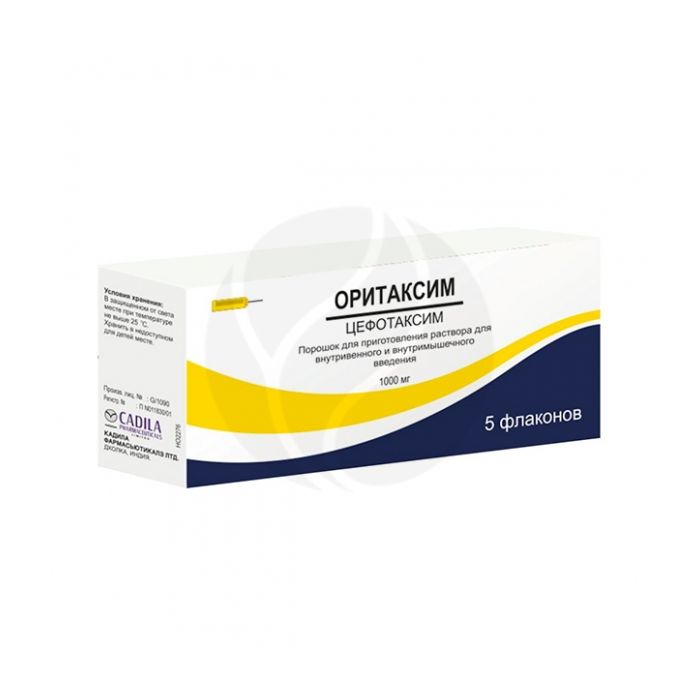Oritaxim powder d / prig.r-ra d / injection 1g, No. 5
Expiration Date: 05/2027
Russian Pharmacy name:
Оритаксим порошок д/приг.р-ра д/инъекций 1г, №5
Severe infectious and inflammatory diseases caused by microorganisms sensitive to cefotaxime, incl. peritonitis, sepsis, abdominal and pelvic infections, infections of the lower respiratory tract, urinary tract infections, infections of bones and joints, skin and soft tissues, infected wounds and burns, gonorrhea, meningitis, Lyme disease.
Prevention of infections after surgery.
Adults and children weighing more than 50 kg - 1-2 g every 4-12 hours intramuscularly or intravenously (jet or drip). Children weighing less than 50 kg - 50-180 mg / kg / day; the frequency of introduction is 2-6 times.
Maximum doses: for adults - 12 g / day, for children weighing less than 50 kg - 180 mg / kg / day.
Powder for the preparation of a solution for intravenous and intramuscular administration of an almost white or light yellow color, crystalline.
1 fl.
cefotaxime (in the form of sodium salt) 1 g
Hypersensitivity to cefotaxime and other cephalosporins.
pharmachologic effect
A cephalosporin antibiotic of the third generation with a broad spectrum of action. It has a bactericidal effect by inhibiting the synthesis of the bacterial cell wall. The mechanism of action is due to acetylation of membrane-bound transpeptidases and disruption of cross-linking of peptidoglycans, which is necessary to ensure the strength and rigidity of the cell wall.
Highly active against gram-negative bacteria (resistant to the action of other antibiotics): Escherichia coli, Citrobacter spp., Proteus mirabilis, Providencia spp., Klebsiella spp., Serratia spp., Some strains of Pseudomonas spp., Haemophilus influenzae.
Less active against Streptococcus spp. (including Streptococcus pneumoniae), Staphylococcus spp., Neisseria meningitidis, Neisseria gonorrhoeae, Bacteroides spp.
Resistant to most ?-lactamases.
Pharmacokinetics
It is rapidly absorbed from the injection site. Plasma protein binding is 40%. It is widely distributed in tissues and body fluids. Reaches therapeutic concentrations in the cerebrospinal fluid, especially in meningitis. Penetrates through the placental barrier, excreted in breast milk in low concentrations. Partially metabolized in the liver. 40-60% of the dose is excreted in the urine unchanged after 24 hours, 20% - in the form of metabolites.
Side effect
From the digestive system: nausea, vomiting, diarrhea, a transient increase in the activity of hepatic transaminases, cholestatic jaundice, hepatitis, pseudomembranous colitis.
Allergic reactions: skin rash, itching, eosinophilia; rarely - Quincke's edema.
From the side of the hematopoietic system: with prolonged use in high doses, changes in the picture of peripheral blood (leukopenia, neutropenia, thrombocytopenia, hemolytic anemia) are possible.
From the side of the blood coagulation system: hypoprothrombinemia.
From the urinary system: interstitial nephritis.
Effects due to chemotherapeutic action: candidiasis.
Local reactions: phlebitis (with intravenous injection), soreness at the injection site (with intramuscular injection).
Application during pregnancy and lactation
The use of cefotaxime in the first trimester of pregnancy is not recommended.
Application in the II and III trimesters of pregnancy and lactation is possible only in cases where the intended benefit to the mother outweighs the potential risk to the fetus or infant.
It should be borne in mind that after intravenous administration of cefotaxime at a dose of 1 g after 2-3 hours, the maximum concentration of the active substance in breast milk averages 0.32 ± 0.09 ?g / ml. With such a concentration, a negative effect on the child's oropharyngeal flora is possible.
In experimental studies on animals, no teratogenic and embryotoxic effects of cefotaxime were found.
Application for impaired renal function
Cefotaxime is used with caution in case of impaired renal function.
Application in children
Cefotaxime is used with caution in newborns.
special instructions
Cefotaxime is used with caution in case of impaired renal function, indications of a history of colitis, as well as in newborns.
In patients with hypersensitivity to penicillins, allergic reactions to cephalosporin antibiotics are possible.
During the treatment period, a positive direct Coombs' reaction and a false-positive urine reaction to glucose are possible.
It should be used with caution in conjunction with 'loop' diuretics.
Drug interactions
Cefotaxime, suppressing the intestinal flora, interferes with the synthesis of vitamin K. Therefore, when used simultaneously with drugs that reduce platelet aggregation (NSAIDs, salicylates, sulfinpyrazone), the risk of bleeding increases. For the same reason, with simultaneous use with anticoagulants, an increase in the anticoagulant effect is noted.
With simultaneous use with aminoglycosides, polymyxin B and loop diuretics, the risk of kidney damage increases.
With simultaneous use with drugs that reduce tubular secretion, the concentration of cefotaxime in the blood plasma increases.
Probenecid slows down the elimination of cefotaxime by reducing the tubular secretion of the latter.

